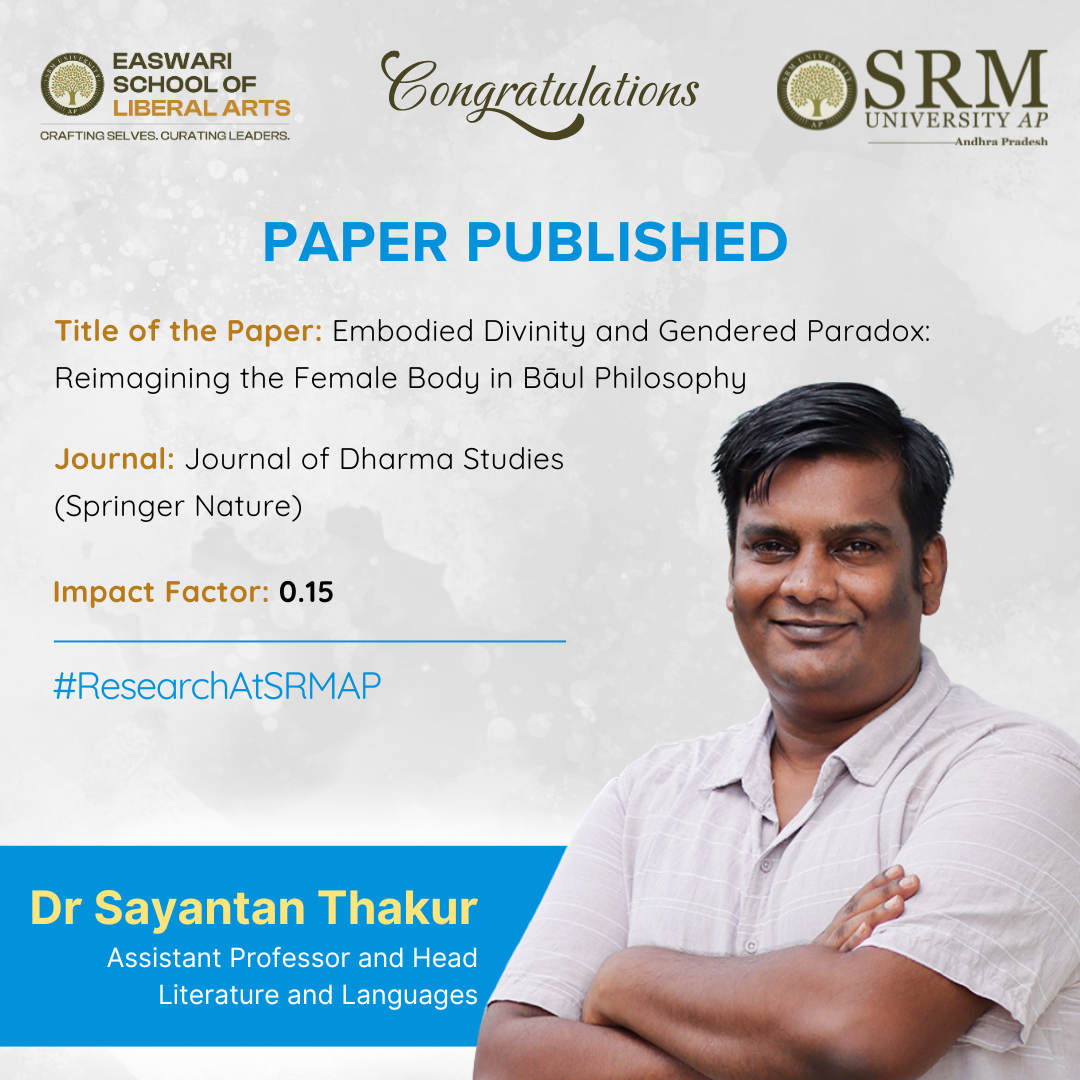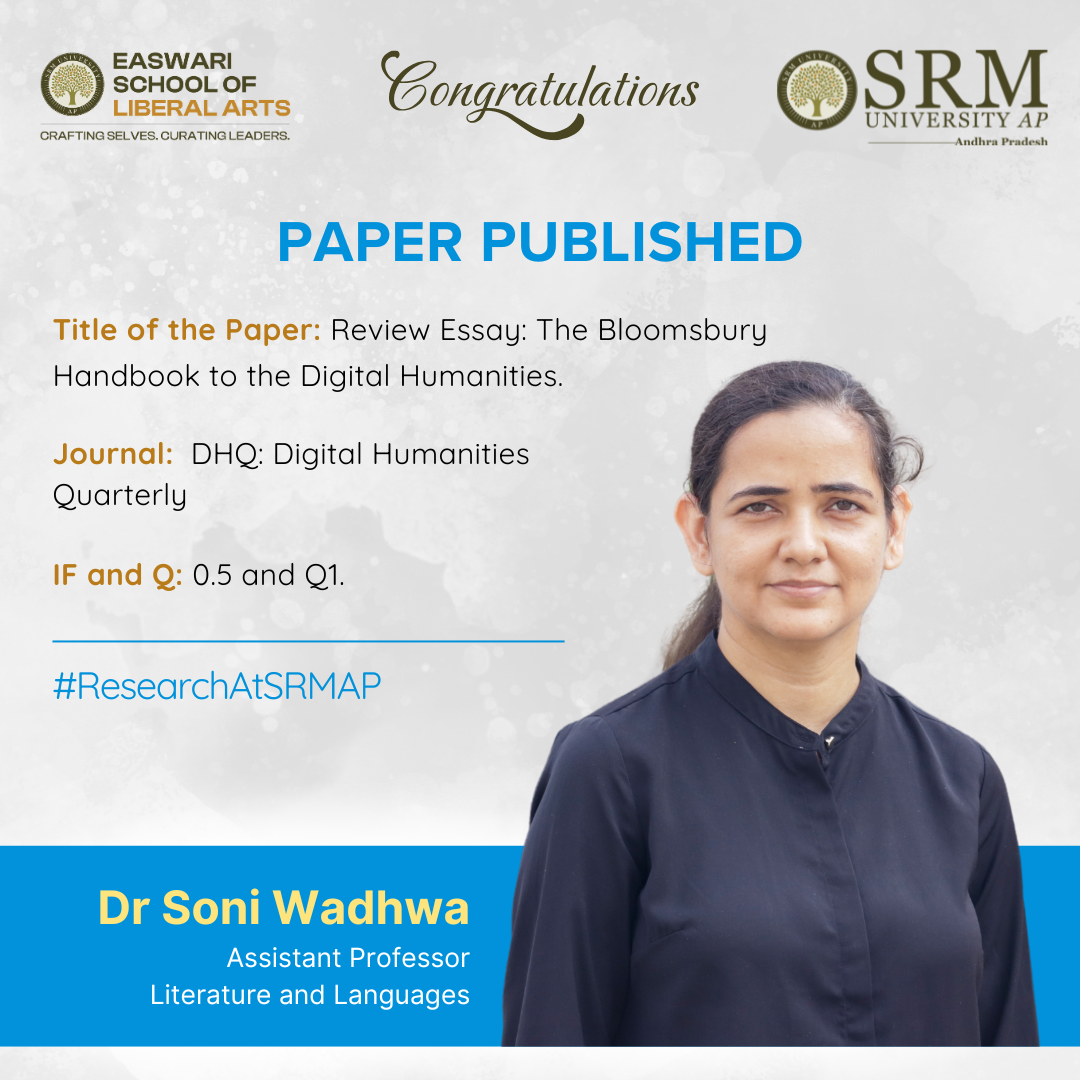- Dr Sayantan Decodes Gender Paradox in Bāul Philosophy July 7, 2025
 Dr Syantan Thakur, Assistant Professor at the Department of Literature and Languages in the Easwari School of Liberal Arts, analyses the Bāull Philosophy through its stories and songs, which project women as a vessel for spiritual realisation and at the same time subject her individuality so as to idealise patriarchal norms. Read the interesting excerpt about his paper to learn more about the topic.
Dr Syantan Thakur, Assistant Professor at the Department of Literature and Languages in the Easwari School of Liberal Arts, analyses the Bāull Philosophy through its stories and songs, which project women as a vessel for spiritual realisation and at the same time subject her individuality so as to idealise patriarchal norms. Read the interesting excerpt about his paper to learn more about the topic.A Brief Abstract of the Research
This research explores how the Bāul tradition of Bengal represents the female body within its mystical and countercultural spiritual philosophy. Central to Bāul belief is deho-tattva—the philosophy that the human body, especially the female body, is the vessel through which spiritual realization is possible. The paper critically examines how women’s bodies are portrayed as sites of divine power (śakti) but are simultaneously idealized in ways that risk reinforcing patriarchal structures. By drawing on feminist theorists like Simone de Beauvoir, Judith Butler, Luce Irigaray, and Rita Gross, the study interrogates whether the Bāul tradition’s symbolic reverence of women genuinely affirms women’s agency or instead reduces them to metaphors for male spiritual advancement. Using Bengali Bāul songs, ethnographic insights, and comparative references to other South Asian mystical traditions, this research argues that the Bāul approach embodies both liberatory and constraining elements for women. The paper calls for an intersectional feminist lens to reconcile these contradictions and to imagine a spiritual practice that fully recognizes the lived experiences and autonomous subjectivity of women within the Bāul cosmos.
Explanation of the Research in Layperson’s Terms
This study looks at a group of mystical singers and spiritual practitioners in Bengal called the Bāuls. They believe that the human body, especially a woman’s body, is sacred and full of divine power. Unlike some other religious traditions that say we should reject the body to find God, the Bāuls say we should honor the body because it connects us to the divine. However, there’s a twist: while the Bāuls praise women’s bodies as powerful and holy, they often do this in ways that turn real women into symbols instead of seeing them as people with their own voices and choices. My research asks: does calling a woman “divine” really help her in everyday life, or does it just make her part of someone else’s story? By studying Bāul songs and talking about feminist ideas, my work tries to show both sides of this spiritual practice—how it can free women from some social limits but also how it might quietly keep old inequalities alive. In the end, it’s about finding a fair balance between spiritual ideas and real-life respect for women
Practical Implementation and Social Implications
This research has important implications for how we think about gender, religion, and cultural traditions today. First, it encourages scholars, artists, and spiritual communities to look critically at how women are represented—not just as sacred symbols but as real people with voices and choices. For Bāul practitioners and followers, the study invites reflection on how to preserve the liberating parts of their tradition while addressing parts that may still reflect patriarchal ideas. Socially, the paper highlights the need for conversations about how spirituality and feminism can work together, especially in India where women often face both religious and cultural restrictions. By showing how the Bāuls both challenge and sometimes uphold old gender roles, this research can help communities, policymakers, and educators find better ways to support women’s rights within cultural practices. Practically, it suggests that empowering female Bāuls—called Bāulinīs—to share their own stories, perform publicly, and teach in their own voices can shift the tradition toward greater gender equality. Overall, this study shows that spiritual traditions can be part of modern conversations about gender justice if we approach them with openness, respect, and critical thinking.
Future Research Plans
- Regional Literature in Translation
- Tantric Tradition and Eastern Indian Literature
- Folk Music of Bengal
- Indian Philosophy, Aesthetics & Literature
- Review of The Bloomsbury Handbook to the Digital Humanities (DH) June 2, 2025
 A handbook is a complex and demanding genre, it must offer a comprehensive overview of a field, articulating its foundational principles, charting ongoing debates, and identifying potential future directions. Such volumes are often judged as much by what they exclude as by what they include. Within this context Dr Soni Wadhwa, Assistant Professor in the Department of Literature and Languages, approached “The Bloomsbury Handbook to the Digital Humanities” in her review essay published in the Q1 journal “DHQ: Digital Humanities Quarterly”.
A handbook is a complex and demanding genre, it must offer a comprehensive overview of a field, articulating its foundational principles, charting ongoing debates, and identifying potential future directions. Such volumes are often judged as much by what they exclude as by what they include. Within this context Dr Soni Wadhwa, Assistant Professor in the Department of Literature and Languages, approached “The Bloomsbury Handbook to the Digital Humanities” in her review essay published in the Q1 journal “DHQ: Digital Humanities Quarterly”.Abstract
The Bloomsbury Handbook, edited by James O’Sullivan is framed as a forward-looking resource aimed at fostering further developments in the field of digital humanities (DH). In his introduction, O’Sullivan notes that the volume is designed to serve three categories of readers: DH experts, the DH-curious, and skeptics. The collection is divided into five thematic sections: “Perspectives & Polemics,” “Methods, Tools, & Techniques,” “Public Digital Humanities,” “Institutional Contexts,” and “DH Futures.” Each section features chapters that provide overviews of key subfields while engaging with specific methodological and theoretical issues.
In her review, Dr Wadhwa refrains from summarising all 43 chapters. Instead, she evaluates what the handbook offers to the different categories of readers it aims to serve. She highlights the volume’s self-critical tone and its ability to generate meaningful dialogue about the contributions and challenges of digital humanities in analysing culture and text.
Dr Wadhwa also addresses the misconceptions and hesitations that often surround digital humanities, particularly among scholars from humanities and social sciences who may feel excluded due to a lack of technical expertise. Her review seeks to demystify the field by showcasing exemplary work from leading scholars, thereby offering guidance to researchers interested in exploring DH.
Practical Implementations and Future Research plans:
She hopes that her essay will encourage aspiring researchers to delve deeper into the various subdomains of digital humanities and engage with the field with greater confidence. Dr Wadhwa emphasises the need for more accessible resources and institutional support for digital humanities, asserting its growing relevance within academia.
Looking ahead, she intends to build further on her work in the area of digital archiving which is a vital subdomain within digital humanities. She plans to write more extensively about the projects she has undertaken, contributing to the evolving discourse and practice of the field.
Continue reading →

